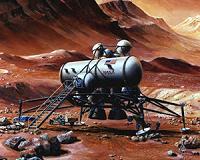 |
Saint Cloud, France (ESA) Sep 20, 2010 ESA has held the first IXV Industrial Workshop. Thales Alenia Space and its main industrial partners presented the detailed design of ESA's Intermediate eXperimental Vehicle. The workshop was hosted by Dassault Aviation in Saint Cloud, France. This was the first opportunity for industry to present the hardware development activities that have been undertaken to support the proposed design solutions. During the event, technical and programmatic achievements in the IXV project were shared, and short- and long-term perspectives and future applications were discussed. "It is a pleasure to see the industry and the research organisations involved in the IXV development so motivated to work on a reentry flight module. This industrial momentum is necessary to accomplish such a mission successfully and timely, while preparing for future challenges together," said Antonio Fabrizi, ESA Director of Launchers.
Intermediate eXperimental Vehicle The Intermediate eXperimental Vehicle (IXV), under ESA's Future Launchers Preparatory Programme (FLPP), is the step forward from the successful Atmospheric Reentry Demonstrator flight in 1998, establishing Europe's role in this field. The IXV project objectives are the design, development, manufacture and ground and flight verification of an autonomous European lifting and aerodynamically controlled reentry system, which is highly flexible and manoeuvrable. Among the critical technologies of interest, special attention has been paid to: + advanced instrumentation for aerodynamics and aerothermodynamics + thermal protection and hot-structure solutions + guidance, navigation and flight control through a combination of thrusters and aerodynamic flaps After being launched into space, IXV will return to Earth as if from a low-orbit mission, testing brand-new European atmospheric reentry technologies during its hypersonic and supersonic flight phases. IXV is scheduled for launch in 2013 on Vega, Europe's new small launcher, as part of the 'VERTA' (Vega Research and Technology Accompaniment) programme. After reentering Earth's atmosphere and being slowed by friction from 7.5 km/s, it will descend by parachute and land in the Pacific Ocean to await recovery and analysis. As IXV flies through Earth's atmosphere, its two-hour mission will include a set of programmed manoeuvres. This will allow scientists and engineers to test the performances of critical technologies. The project is now well under way. The Critical Design Review will start at the end of 2010 and last three months. This will allow for the start of manufacturing in 2011, the verification and qualification process in 2012 and the final assembly and integration in 2013. "The IXV programme is creating a robust European industrial community, which is motivated and committed to the mission's success," said Giorgio Tumino, IXV Project Manager. "The mission will consolidate European knowhow in atmospheric reentry with limited risk and at affordable cost." "It may open the opportunity for future applications such as unmanned space vehicles for in-orbit monitoring and satellite servicing."
Share This Article With Planet Earth
Related Links Intermediate eXperimental Vehicle Space Tourism, Space Transport and Space Exploration News
 Cyborgs Needed For Escape From Earth
Cyborgs Needed For Escape From EarthMoffett Field CA (SPX) Sep 17, 2010 Scientists have warned for decades that humans are straining the Earth. The global population is increasing, economies are expanding and consumption doesn't appear to be slowing. While save-the-planet campaigns are asking people to save energy, conserve water, recycle and even go vegetarian, some scientists are thinking literally out of this world by suggesting that humans may eventually h ... read more |
|
| The content herein, unless otherwise known to be public domain, are Copyright 1995-2010 - SpaceDaily. AFP and UPI Wire Stories are copyright Agence France-Presse and United Press International. ESA Portal Reports are copyright European Space Agency. All NASA sourced material is public domain. Additional copyrights may apply in whole or part to other bona fide parties. Advertising does not imply endorsement,agreement or approval of any opinions, statements or information provided by SpaceDaily on any Web page published or hosted by SpaceDaily. Privacy Statement |